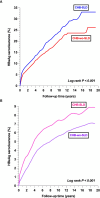Impact of hepatic steatosis on mortality, hepatocellular carcinoma, end-stage liver disease and HBsAg seroclearance in chronic hepatitis B: a United States cohort study
- PMID: 40255390
- PMCID: PMC12006825
- DOI: 10.3389/fimmu.2025.1566925
Impact of hepatic steatosis on mortality, hepatocellular carcinoma, end-stage liver disease and HBsAg seroclearance in chronic hepatitis B: a United States cohort study
Abstract
Background: Steatotic liver disease (SLD) is prevalent among individuals with chronic hepatitis B virus (CHB), yet its impact on clinical outcomes remains controversial.
Methods: We used electronic health record data from 98 US healthcare-delivery systems to compare adults with (CHB-SLD) and without SLD (CHB-wo-SLD) from 2000 to 2024. We applied 1: 1 propensity score matching to balance cohorts by demographic and clinical characteristics. We further performed sensitivity analyses in the presence or absence of cirrhosis. We compared incidence rates (IR) and hazard ratios (HRs) of all-cause mortality, hepatocellular carcinoma (HCC), end-stage liver disease (ESLD) events, and detectable HBsAg and HBeAg as markers of seroclearance.
Results: Among 124,932 individuals with CHB (12.43% CHB-SLD), there were 470,707 person-years of observations (median follow-up 2.95 years). Compared with CHB, individuals with CHB-SLD had a lower mortality risk (HR 0.44, 95% CI 0.40-0.48). Fibrosis risk was higher among those with CHB-SLD (vs CHB-wo-SLD) (HR 1.93, 95% CI 1.71-2.19); however, cirrhosis risk was comparable (HR 1.06, 95% CI 0.96-1.18) between cohorts, while HCC risk was lower in the CHB-SLD cohort (HR 0.83, 95% CI 0.70-0.96). The CHB-SLD cohort also had significantly reduced risks of ESLD events, including ascites, spontaneous bacterial peritonitis, variceal bleeding, hepatic encephalopathy, and hepatorenal syndrome (all p < 0.001). Additionally, detectable HBsAg and HBeAg IRs and HRs were lower among CHB-SLD compared to the CHB-wo-SLD cohort: 26.83 vs. 31.96 per 1,000 person-years (HR 0.80, 95% CI 0.73-0.87) and 8.52 vs. 11.36 per 1,000 person-years (HR 0.74, 95% CI 0.65-0.85), respectively. Sensitivity analyses stratified by cirrhosis status supported these findings.
Conclusion: CHB-SLD status was associated with more favorable outcomes, highlighting the complexity of CHB and SLD interactions.
Keywords: cirrhosis; end-stage liver disease; fibrosis; hepatitis B virus; hepatocellular carcinoma; mortality; steatotic liver disease.
Copyright © 2025 Yendewa, Elangovan, Olasehinde, Mulindwa, Cater, Salata and Jacobson.
Conflict of interest statement
The authors declare that the research was conducted in the absence of any commercial or financial relationships that could be construed as a potential conflict of interest. The author(s) declared that they were an editorial board member of Frontiers, at the time of submission. This had no impact on the peer review process and the final decision.
Figures


Similar articles
-
Association Between Fatty Liver and Cirrhosis, Hepatocellular Carcinoma, and Hepatitis B Surface Antigen Seroclearance in Chronic Hepatitis B.J Infect Dis. 2021 Jul 15;224(2):294-302. doi: 10.1093/infdis/jiaa739. J Infect Dis. 2021. PMID: 33249474
-
Mechanisms of hepatocellular carcinoma and cirrhosis development in concurrent steatotic liver disease and chronic hepatitis B.Clin Mol Hepatol. 2025 Feb;31(Suppl):S182-S195. doi: 10.3350/cmh.2024.0837. Epub 2024 Nov 21. Clin Mol Hepatol. 2025. PMID: 39568126 Free PMC article. Review.
-
All-cause and cause-specific mortality in patients with chronic hepatitis B and concurrent steatotic liver disease.J Hepatol. 2025 Jul;83(1):43-51. doi: 10.1016/j.jhep.2024.12.009. Epub 2024 Dec 14. J Hepatol. 2025. PMID: 39675434
-
Impact of fatty liver on long-term outcomes in chronic hepatitis B: a systematic review and matched analysis of individual patient data meta-analysis.Clin Mol Hepatol. 2023 Jul;29(3):705-720. doi: 10.3350/cmh.2023.0004. Epub 2023 May 8. Clin Mol Hepatol. 2023. PMID: 37157776 Free PMC article.
-
Risk of hepatic decompensation but not hepatocellular carcinoma decreases over time in patients with hepatitis B surface antigen loss.J Hepatol. 2023 Mar;78(3):524-533. doi: 10.1016/j.jhep.2022.11.020. Epub 2022 Dec 2. J Hepatol. 2023. PMID: 36463985
References
MeSH terms
Substances
LinkOut - more resources
Full Text Sources
Medical

